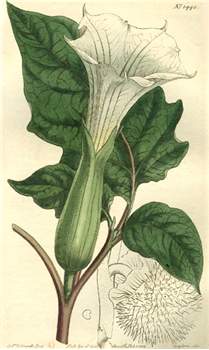
Taxonomy
Datura L., Sp. Pl. 1: 179 (1753), & Gen. Pl. 5th edn, 83 (1754); from the Hindi dhatura, the name given to D. fastuosa L. and D. metel L.
Type species: D. stramonium L.
Summer-growing annual herbs to 1.2 m, or short-lived perennials, glabrous or pubescent with glandular or simple, non-glandular hairs. Leaves alternate, simple, entire or lobed, petiolate. Flowers solitary in forks of stems, bisexual, actinomorphic. Calyx tubular, the lobes 5 (occasionally 3, 4 or up to 9); base persistent in fruit. Corolla funnel- or trumpet-shaped, rarely multiple, white or variously coloured; limb shortly 5–lobed or appearing 10–lobed, folded and twisted in bud. Stamens usually 5, equal in height, inserted in lower half of corolla-tube. Anthers bilocular, basifixed, dehiscing by longitudinal slits. Ovary bilocular, or falsely 4–locular in lower half; stigma saddle-shaped. Fruit a 2–4–locular, spiny or tuberculate capsule, opening regularly or irregularly from apex. Seeds approximately D-shaped.
A genus of 10 species occurring naturally in tropical and warm-temperate Central and South America, China, Asia and north Africa. Some species have a long history of use as drug plants. One species, Datura leichhardtii F. Muell. ex Benth., generally considered endemic to Australia; five species naturalised and declared noxious weeds in most States. Sometimes toxic to stock.
W.E. Safford, Synopsis of the genus Datura, J. Wash. Acad. Sci. 11: 173–189 (1921); A.G. Avery, S. Satina & J. Rietsema, Blakeslee: The genus Datura, Chronica Botanica 20 (1959); L. Haegi, Taxonomic account of Datura L. (Solanaceae) in Australia with a note on Brugsmansia Pers., Austral. J. Bot. 24: 415–435 (1976); E. S. Hadkins, R. Bye, W. A. Brandenburg, C. E. Jarvis (1997).Typification of Linnaean Datura names (Solanaceae). Bot. J. Linnean Soc. 125: 295-308.
Datura and Brugmansia - how they differ
Brugmansia has often been confused with Datura. The two genera are easily distinguished by the long-lived, softly woody bushes reaching up to 4 m high for Brugmansia as opposed to the short lived, summer flowering annuals of Datura. In addition Brugmansia has pendent flowers on 3-6 cm long pedicels and non spiny fruits while Datura has erect flowers on 0.5-1.5 cm long pedicels and spiny fruits (Haegi 1976).
Additional information and images on the web
The American Brugmansia & Datura Society maintains a web-site which is rich in images of the species of the two genera and also has a key to the American species of the two genera; unfortunately this previously freely available site is now only available to members. At the time of the Flora of Australia treatment there were no records of Brugmansia, despite its wide cultivation, having naturalised in Australia. Now there are sporadic records from northern NSW and SW Qld of two species having escaped from the garden environment, one the species B. suaveolens and the other the hybrid referred to as B. x candida.
Brugmansia is easily distinguished from Datura by its long-lived, softly woody bushes which reach up to 4 m high and which have pendent, rather than erect, flowers. Fruits are spiny in Datura while they are smooth in Brugmansia.
An image of the symmetry of an opening Datura flower can be seen at http://arne.kaiser.googlepages.com/Datura.jpg/Datura-full.jpg
Taxonomic notes since the 1982 Flora of Australia treatment.
Sect. Datura, with erect fruit, encompasses the species D. ferox and D. stramonium, while the other four species in Australia belong with Sect. Dutra, characterised by deflexed and spiny fruits. A Mexican study of Datura species using starch gel electrophoresis (Jiao et al., 2002) suggests that the presently recognised three sections in Datura should be increased to four, with the splitting of Sect. Dutra into two.
Jiao, M. Luna-Cavazos, M. & Bye, R. (2002). Allozyme variation in Mexican species and classification of Datura (Solanaceae). Plant Syst. Evol. 232: 155-166.
Datura species as hallucinogens
Bonde, Kirsten (2001). The Genus Datura: From Research Subject to Powerful Hallucinogen. http://leda.lycaeum.org/?ID=16212
Key to species
Key adapted from L. Haegi, Taxonomic account of Datura L. (Solanaceae) in Australia with a note on Brugmansia Pers. Australian J. Botany 24: 421–422 (1976).
1 Leaves lobed, the lobes usually toothed or sinuate; capsule erect; seeds black or grey
2 Flowers 6–10 cm long; capsule with more than 100 slender spines of various lengths, randomly distributed
Datura stramonium
2: Flowers 4.5–6 cm long; capsule with 40–60 stout spines, upper longer than lower
Datura ferox
1: Leaves entire to sinuate or lobed, the lobes entire; capsule deflexed; seeds brown or yellow
3 Plants glabrous or sparsely pubescent with non-glandular hairs
4 Branches green; flowers 4.5–7 cm long; capsule with numerous sharp spines
Datura leichhardtii
4: Branches tinged with purple; flowers 14–20 cm long; capsule with numerous short, blunt tubercles
Datura metel
3: Plants tomentose with non-glandular and/or glandular hairs
5 Hairs glandular, erect; stigma well below level of anthers; margin of corolla limb angular
Datura inoxia
5: Hairs mostly non-glandular and retrorse, some glandular and erect; stigma usually exserted well above anthers; margin of corolla limb rounded
Datura wrightii

